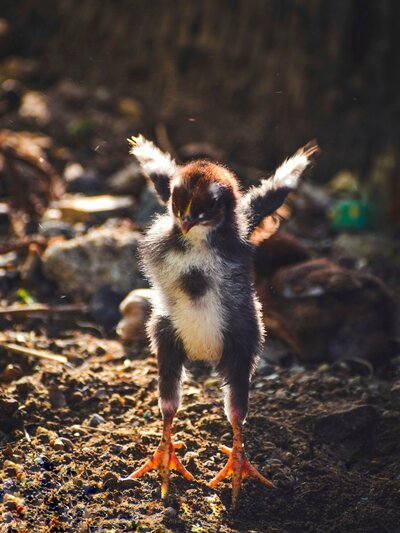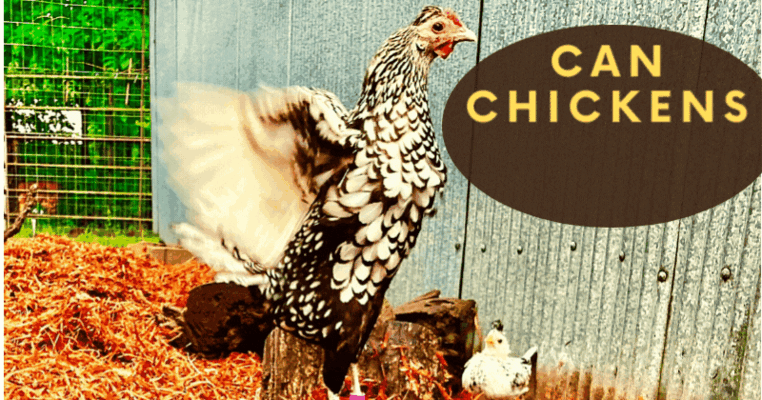Although chickens are thought by some to never leave the ground, they have large, feathery wings like most birds. So we often wonder what those wings are for. To determine if chickens can fly like other birds, let's look at their behavior and history.
They can fly, but it's rare. On the rare occasion they do fly, they only go a short distance before returning to the ground. So there won't be a flock of chickens flying south for the winter, but you might see them flying to a perch or away from predators. Fortunately, the majority of chickens aren't good enough at flying to escape their enclosure space.
Here are some of the best flying chicken breeds:
The only chicken breed that doesn't fly is the silkie.
But chickens had difficulty flying, even as wild birds. Before they were domesticated, they spent most of their time in the jungle, living in low tree branches protected by plants. Therefore, they could hide in the dense canopy rather than flee from predators. So it was unnecessary for them to fly higher than the tree branches.
After some time, humans began breeding chickens to create the many breeds we know today. As chickens became more domesticated, their need to fly decreased even more as they became more dependent on humans.
Additionally, humans have bred chickens to produce more meat and eggs, so their body-to-wing ratio isn't as it used to be. It is harder for many breeds to lift themselves off the ground because they are larger and heavier to provide more meat.
Chicken breeds that are better at flying are those that have changed the least over time. The La Flèche, for example, is a breed that has barely changed, so it still flies just as well as its ancestors. Even so, they weren't the best fliers.
To fly long distances, birds need an ideal ratio of body mass to wing area, but modern chickens have disproportionate bodies. In order to fly optimally, birds need 0.6 ounces of wing area per sq inch of body weight, which most chickens do not have. As a result, chickens can only fly a few feet at a time, and it is rare that they will attempt to fly.
In some cases, young chickens can fly farther, but they will not be able to escape. As chickens are considered to be "nearly flightless", they rarely require a roof to keep them safe.
Occasionally, chickens can become bored as well, so by providing them with toys and other items to focus on, they are less likely to flee.
Be sure, however, to give your chickens enough space in their run if it is completely enclosed. By giving them more space, they will be healthier and less likely to escape.
However, many people shy away from this solution because it disadvantages chickens. They are unable to escape quickly if approached by a predator. Only when absolutely necessary should your chicken's feathers be clipped.
Birds with clipped wings can't be entered into competitions. In addition, never trim a chicken's primary flight feathers if they are still growing. Clip wings only when they are fully developed. If not, it could hurt your chicken.
Additionally, if you have heavier chickens, such as Orpingtons, as opposed to lighter breeds, they won't be able to fly as far. Therefore, they are unlikely to fly away even if they do take off.
They can fly, but it's rare. On the rare occasion they do fly, they only go a short distance before returning to the ground. So there won't be a flock of chickens flying south for the winter, but you might see them flying to a perch or away from predators. Fortunately, the majority of chickens aren't good enough at flying to escape their enclosure space.
Can All Chicken Breeds Fly?
Unless specifically bred differently, all chicken breeds have similar flying abilities. Some chickens have slimmer structures, enabling them to hold themselves in the air longer and fly farther.Here are some of the best flying chicken breeds:
- Ancona
- Andalusian
- Campine
- Catalana
- Leghorn
The only chicken breed that doesn't fly is the silkie.
How Far Can a Chicken Fly?
A chicken flew 301.5 feet in 2014, which is the longest flight a chicken has ever made. The average chicken is only able to fly 50 feet at a time. The record flight lasted only 13 seconds.What is the Highest Distance a Chicken Can Fly?
There is no record for the height a chicken can fly, but some breeds are able to rise over 30 feet, high enough to perch on top of a barn. However, most chickens cannot fly higher than 10 feet.History of Chicken Flight
Humans have been capturing and caring for chickens for thousands of years. Food was the most important need, even though hens and roosters were regularly used for fighting. There is evidence that domesticated chickens have been raised and used for meat and eggs for at least 7,400 years.But chickens had difficulty flying, even as wild birds. Before they were domesticated, they spent most of their time in the jungle, living in low tree branches protected by plants. Therefore, they could hide in the dense canopy rather than flee from predators. So it was unnecessary for them to fly higher than the tree branches.
After some time, humans began breeding chickens to create the many breeds we know today. As chickens became more domesticated, their need to fly decreased even more as they became more dependent on humans.
Additionally, humans have bred chickens to produce more meat and eggs, so their body-to-wing ratio isn't as it used to be. It is harder for many breeds to lift themselves off the ground because they are larger and heavier to provide more meat.
Chicken breeds that are better at flying are those that have changed the least over time. The La Flèche, for example, is a breed that has barely changed, so it still flies just as well as its ancestors. Even so, they weren't the best fliers.
So Why do Chickens Fly?
Chickens in captivity usually don't need to fly, but occasionally you may see them do so.To Avoid Predators
Chickens fly primarily to avoid predators. If they see a predator approaching too closely, they may take off in flight. There are some breeds that can take off within seconds while others need to take a few steps to get going.To Escape
Chickens might also fly for curiosity's sake. While it is unlikely that they will escape or get far, they might try to fly over a fence to see what lies on the other side. There might be an incentive for the chickens to fly over to your neighbor's yard if they have flowers and vegetables to eat.Just for Fun
A chicken might fly to land on a perch. There are also those who fly just because they can. Flying might become the most interesting pastime if they don't have enough things to entertain themselves in their coop.What makes chickens bad at flying?
Some people refer to chickens as "game birds" along with quails and pheasants. Although game birds have large bodies and strong flight muscles, they cannot fly very far. To escape predators, they can fly in rapid, vertical motions using their muscles, but they quickly tire.To fly long distances, birds need an ideal ratio of body mass to wing area, but modern chickens have disproportionate bodies. In order to fly optimally, birds need 0.6 ounces of wing area per sq inch of body weight, which most chickens do not have. As a result, chickens can only fly a few feet at a time, and it is rare that they will attempt to fly.
In some cases, young chickens can fly farther, but they will not be able to escape. As chickens are considered to be "nearly flightless", they rarely require a roof to keep them safe.
If your chicken flies, what should you do?
Chickens usually won't get far enough away to escape, and if they do, they usually return. Nonetheless, if you're concerned about chickens being able to fly, here are some things you can do.Let Them Fly
If you don't want to, you don't have to do anything. Even if chickens are able to scale the fence, they won't run away. They might be curious during the day and want to perch somewhere new, but chickens tend to return to the chicken coop at dusk as it's a comfortable, safe place.Provide Food and Entertainment
The chickens might leave their enclosure if they are dissatisfied. Food and water dispensers should be easy to reach so that they won't need to go elsewhere to find their basic needs.Occasionally, chickens can become bored as well, so by providing them with toys and other items to focus on, they are less likely to flee.
Place Higher Perches
Your chickens may start flying to find higher places to roost if the perches in your coop are all too low to the ground. In the event that they roost somewhere else overnight, they could be threatened by predators. Therefore, providing them with perches of varying heights will discourage them from leaving.Cover Their Run
Alternatively, you can build a higher fence around your coop or provide a cover. The risk of them escaping can be eliminated by covering their run with chicken wire or mesh netting. It is also a cost-effective way of preventing wild animals from getting in.Be sure, however, to give your chickens enough space in their run if it is completely enclosed. By giving them more space, they will be healthier and less likely to escape.
Clip Their Wings
Trimming the chickens' wings seems like a logical solution for chicken keepers who don't want to confine their chickens. They won't be able to fly as far if their wings are trimmed a couple of inches.However, many people shy away from this solution because it disadvantages chickens. They are unable to escape quickly if approached by a predator. Only when absolutely necessary should your chicken's feathers be clipped.
Birds with clipped wings can't be entered into competitions. In addition, never trim a chicken's primary flight feathers if they are still growing. Clip wings only when they are fully developed. If not, it could hurt your chicken.
Provide the best chicken environment possible.
Chickens can fly, but you shouldn't worry about them escaping. Even wild chickens lacked the ability to fly. If your chickens are provided with a spacious environment with all their basic needs, they are unlikely to feel the need to run away.Additionally, if you have heavier chickens, such as Orpingtons, as opposed to lighter breeds, they won't be able to fly as far. Therefore, they are unlikely to fly away even if they do take off.


